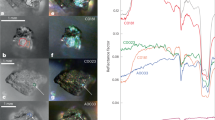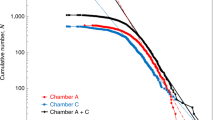Abstract
The characterization of objects that have best preserved the mineralogical and molecular phases formed in the earliest stages of the Solar System evolution is key to understanding the processes that led to the formation of the planets in their diversity. The Hayabusa2 mission of the Japan Aerospace Exploration Agency has returned for the first time samples collected at the surface of a C-type asteroid, Ryugu1,2. They are now preserved at the Extraterrestrial Samples Curation Center of the Japan Aerospace Exploration Agency at the Institute of Space and Astronautical Science in Sagamihara, Japan, where they are submitted to a first round of purely non-destructive analyses. The MicrOmega hyperspectral microscope developed at the Institut d'Astrophysique Spatiale (Orsay, France), which operates in the near-infrared range (0.99–3.65 µm), is performing their mineralogical and molecular characterization down to the scale of a few tens of micrometres. Strong features at 2.7 µm (indicating their OH-rich content) and at 3.4 µm (diagnostic of the presence of organics) dominate at a global scale, but key distinctive signatures have been identified at a submillimetre scale. In particular, carbonates (a fraction of them enriched in iron) as well as NH-rich compounds have been detected. The occurrence of volatile-rich species, likely originating from the outer Solar System, would support Ryugu having preserved both pristine material and altered phases, which are now available for refined laboratory analyses with the potential to draw new insights into the formation and evolution paths of planetary bodies in our Solar System.
This is a preview of subscription content, access via your institution
Access options
Access Nature and 54 other Nature Portfolio journals
Get Nature+, our best-value online-access subscription
$29.99 / 30 days
cancel any time
Subscribe to this journal
Receive 12 digital issues and online access to articles
$119.00 per year
only $9.92 per issue
Buy this article
- Purchase on Springer Link
- Instant access to full article PDF
Prices may be subject to local taxes which are calculated during checkout




Similar content being viewed by others
Data availability
All the data related to this manuscript will be put on the Data ARchives and Transmission System (DARTS) after a one-year proprietary period.
References
Watanabe, S. et al. Hayabusa2 arrives at the carbonaceous asteroid 162173 Ryugu—A spinning top-shaped rubble pile. Science 364, 268–272 (2019).
Morota, T. et al. Sample collection from asteroid (162173) Ryugu by Hayabusa2: implications for surface evolution. Science 368, 654–659 (2020).
Arakawa, M. et al. An artificial impact on the asteroid (162173) Ryugu formed a crater in the gravity-dominated regime. Science 368, 67–71 (2020).
Yada, T. et al. Preliminary analysis of the Hayabusa2 samples returned from C-type asteroid Ryugu. Nat. Astron. https://doi.org/10.1038/s41550-021-01550-6 (2021).
Bibring, J.-P. et al. The MicrOmega investigation onboard ExoMars. Astrobiology 17, 621–626 (2017).
Hunt, G. R. Spectral signatures of particulate minerals in the visible and the near infrared. Geophysics 42, 501–513 (1977).
Clark, R. N., King, T. V. V., Klejwa, M., Swayze, G. A. & Vergo, N. High spectral resolution reflectance spectroscopy of minerals. J. Geophys. Res. 95, 12653–12680 (1990).
Clark, R. N., Curchin, J. M., Hoefen, T. M. & Swayze, G. A. Reflectance spectroscopy of organic compounds: 1. Alkanes. J. GeoPhys. Res. 114, E03001 (2009).
Ferrari, M. et al. Reflectance spectroscopy of ammonium-bearing phyllosilicates. Icarus 321, 522–530 (2019).
Riu, L., Bibring, J.-P., Pilorget, C., Poulet, F. & Hamm, V. The on-ground calibration performances of the hyperspectral microscope MicrOmega for the Hayabusa-2 mission. Planet. Space Sci. 152, 31–44 (2018).
Kitazato, K. et al. The surface composition of asteroid 162173 Ryugu from Hayabusa2 near-infrared spectroscopy. Science 364, 272–275 (2019).
Sugita, S. et al. The geomorphology, color, and thermal properties of Ryugu: implications for parent-body processes. Science 364, 252–252 (2019).
Binzel, R.P., Lupishko, D., di Martino, M., Whiteley, R.J. & Hahn, G.J. in Asteroids III (eds Bottke, W. F. Jr et al.) 255–271 (Univ. of Arizona Press, 2002).
Vilas, F. Spectral characteristics of Hayabusa 2 near-Earth asteroid targets 162173 1999 JU3 and 2001 QC34. Astron. J. 135, 1101–1105 (2008).
Kitazato, K. et al. Thermally altered subsurface material of asteroid (162173) Ryugu. Nat. Astron. 5, 246–250 (2021).
Jaumann, R. et al. Images from the surface of asteroid Ryugu show rocks similar to carbonaceous chondrite meteorites. Science 365, 817–820 (2019).
Kebukawa, Y., Conel Alexander, M. O.’D. & Cody, GeorgeD. Compositional diversity in insoluble organic matter in type 1, 2 and 3 chondrites as detected by infrared spectroscopy. Geochim. Cosmochim. Acta 75, 3530–3541 (2011).
Kaplan, H., Milliken, R. E., Alexander Conel, M. O.’D. & Herd, C. D. K. Reflectance spectroscopy of insoluble organic matter (IOM) and carbonaceous meteorites. Meteorit. Planet. Sci. 54, 1051–1068 (2019).
Ehlmann, B. L. et al. Ambient and cold-temperature infrared spectra and XRD patterns of ammoniated phyllosilicates and carbonaceous chondrite meteorites relevant to Ceres and other solar system bodies. Meteorit. Planet. Sci. 53, 1884–1901 (2018).
Hunt, G. R. & Salisbury, J. W. Visible and near-infrared spectra of minerals and rocks: II Carbonates. Mod. Geol. 2, 23–30 (1971).
Endress, M., Zinnert, E. & Bischoff, A. Early aqueous activity on primitive meteorite parent bodies. Nature 379, 701–703 (1996).
Kaplan, H. H. et al. Bright carbonate veins on asteroid (101955) Bennu: implications for aqueous alteration history. Science 370, eabc3557 (2020).
Endress, M. & Bischoff, A. Carbonates in C1 chondrites: clues to parent body evolution. Geochim. Cosmochim. Acta 60, 489–507 (1996).
De Leuw, S., Rubin, A. E. & Wasson, J. T. Carbonates in CM chondrites: complex formational histories and comparison to carbonates in CI chondrites. Meteorit. Planet. Sci. 45, 513–530 (2010).
Acknowledgements
We are very grateful to have been invited by the Hayabusa2 Project to contribute to their outstanding mission. We thank the French space agency CNES for its full support. The Japan Society for the Promotion of Science (JSPS) provided support through KAKENHI grant no. 17H06459 (T.U. and T.O.) and grant no. 19K03958 (M.A.). We also acknowledge the JSPS Core-to-Core Program ‘International Network for Planetary Science’.
Author information
Authors and Affiliations
Contributions
V.H., M.C., B.C., G.L., L.L., J.-P.B. and C.P. contributed to the instrument development. T.Y., T.O., L.L., V.H., L.R., A.N., K.Y. G.L., J.-P.B., C.P., D.L. and R.B. contributed to the installation of the instrument in the Curation Facility and to the protocol development. L.R., V.H., C.L., J.-P.B. and C.P. contributed to the calibration. J.-P.B., C.P., V.H., L.R., T.Y., D.L., R.B., K.H., A.N., K.Y., C.L., T.L.P.-J., G.L., L.L., K.Kumagai., A.M. and M.N. participated in the operations. B.G., D.L., J.-P.B., L.R., R.B., C.P., K.H., A.N., K.Y., J.C., Y.L., T.L.P.-J., C.L., F.P. and A.A.-T. contributed to the data analysis and interpretation. J.-P.B., C.P. and R.B. wrote the draft of the manuscript. All authors were involved in the discussions of the results and the finalization of the manuscript.
Corresponding author
Ethics declarations
Competing interests
The authors declare no competing interests.
Additional information
Peer review information Nature Astronomy thanks Beth Clark, Hannah Kaplan and the other, anonymous, reviewer(s) for their contribution to the peer review of this work.
Publisher’s note Springer Nature remains neutral with regard to jurisdictional claims in published maps and institutional affiliations.
Rights and permissions
Springer Nature or its licensor (e.g. a society or other partner) holds exclusive rights to this article under a publishing agreement with the author(s) or other rightsholder(s); author self-archiving of the accepted manuscript version of this article is solely governed by the terms of such publishing agreement and applicable law.
About this article
Cite this article
Pilorget, C., Okada, T., Hamm, V. et al. First compositional analysis of Ryugu samples by the MicrOmega hyperspectral microscope. Nat Astron 6, 221–225 (2022). https://doi.org/10.1038/s41550-021-01549-z
Received:
Accepted:
Published:
Issue Date:
DOI: https://doi.org/10.1038/s41550-021-01549-z
This article is cited by
-
Ammonium-rich bright areas on Ceres demonstrate complex chemical activity
Communications Earth & Environment (2024)
-
A newly revised estimation of bulk densities and examination of the shape of individual Ryugu grains
Earth, Planets and Space (2023)
-
Homogeneity and heterogeneity in near-infrared FTIR spectra of Ryugu returned samples
Earth, Planets and Space (2023)
-
A sample return renaissance
Nature Astronomy (2023)
-
Variations of the surface characteristics of Ryugu returned samples
Earth, Planets and Space (2023)



